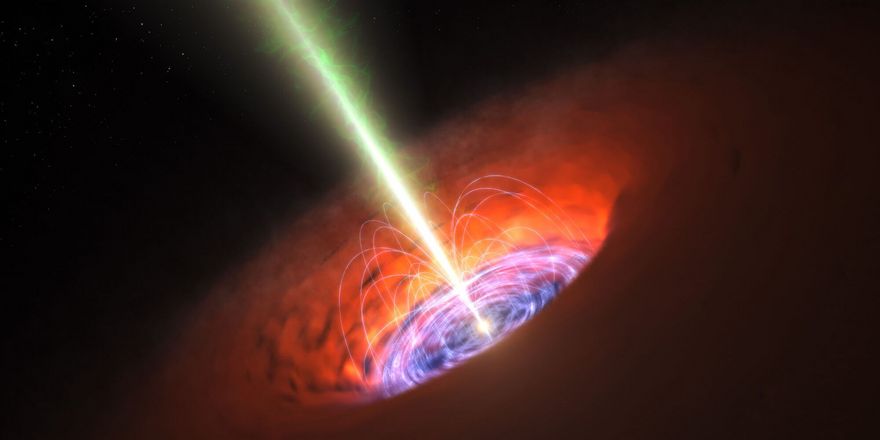Press releases
![[Translate to English:] #33956 Left: The MAGIC telescopes on the island of La Palma. Right: Data from the eruption of the active galactic nucleus (AGN) Markarian 421, measured with MAGIC (gamma rays) and IXPE (X-rays) in December 2023 (Photo: Urs Leutenegger, Data: Axel Arbet-Engels)](/fileadmin/_processed_/f/6/csm_plot_pr_8224fe035a.jpg)
Left: The MAGIC telescopes on the island of La Palma. Right: Data from the eruption of the active galactic nucleus (AGN) Markarian 421, measured with MAGIC (gamma rays) and IXPE (X-rays) in December 2023 (Photo: Urs Leutenegger, Data: Axel Arbet-Engels)
New insights into cosmic jets: Multiple observatories sharpen the picture
It is known that the radiation from AGN is powered by supermassive black holes whose mass is millions or even billions of times greater than that of our sun. In every tenth AGN, the black hole ejects jets of matter into its surroundings. These enormous cosmic jets travel at almost the speed of light and extend over huge distances of up to several million light years. This corresponds to the distance between the Milky Way and the Andromeda galaxy, our neighboring spiral galaxy. Jets emit gamma rays - the most energetic radiation we know of. Despite decades of observations, the mechanisms that drive these jets and generate gamma rays are still unclear. What is clear, however, is that the gamma rays originate from particles that have been accelerated to the highest energies.
"The more the wavelengths differ the more we understand"
The MAGIC observatory, with its two telescopes on La Palma, is designed to detect high-energy gamma radiation from cosmic sources, particularly from Active Galactic Nuclei. But AGN aren't just gamma-ray emitters, they shine across the entire electromagnetic spectrum. "That's why combining MAGIC's observations with those from other instruments is so important," explains Axel Arbet-Engels from the Gamma Astronomy Group at the MPP. "The more different wavelengths we observe – like optical, infrared, or radio light – the more we understand the events taking place in these powerful objects."
For over 15 years, a research team at the MPP has been coordinating multi-instrument observations of two bright AGN: Markarian 421 and Markarian 501. These are blazars, a special type of AGN where powerful jets are pointed almost directly towards Earth, giving us a unique view. These blazars are located about 400 million light-years away. Since 2022, data from the Imaging X-ray Polarimetry Explorer (IXPE), a space-based observatory, has also been included in the investigations*. This has led to more detailed insights, revealing new clues about the inner workings of these cosmic powerhouses.
The role of magnetic fields

IXPE is the first instrument capable of measuring X-ray polarization, which provides information about the structure, ordering and direction of the magnetic fields existing in the cosmic sources. The scientists measured an increase in the X-ray emission, which was temporarily correlated with an enhanced gamma-ray radiation, as measured by MAGIC. This indicates that both X-rays and gamma rays are produced in the same location and by the same high-energy particle population. Combining IXPE with MAGIC enables the scientists to investigate for the first time how magnetic fields influence the acceleration of particles and the formation of X-rays and gamma rays in the jet.
Within just two years, the MPP research team published the first two multi-instrument studies including simultaneous IXPE and MAGIC data. "We found that the X-ray polarization is many times higher than in the optical and radio bands," says Axel Arbet-Engels. "This points to an energy-stratified jet, in which very high-energy gamma rays are emitted along with X-rays near a shock front.” This indicates a boundary where the fast-moving plasma collides with slower material, causing a sudden increase in the temperature, pressure, and particle acceleration. "We suspect the following scenario: at the jet's point of origin, there is a compact zone in which the X-rays and the most energetic gamma rays dominate. There is also a more extensive region further downstream in the jet, which is responsible for the emission in the optical and radio range."
Magnetic turbulences
In December 2023, the researchers had the first opportunity to study a large outburst of the AGN Markarian 421 with MAGIC, the X-ray polarimeter IXPE and other instruments simultaneously. The outburst that occurred simultaneously in the gamma-rays and X-rays, was accompanied by strong temporal variations of the X-ray polarization, which had not yet been observed before. The results underline the crucial role of magnetic turbulences in the variable behaviour of blazars. They suggest that the X-rays and high-energy gamma rays originate from a shock wave created by compression in the jet, which can accelerate particles and thus generate high-energy radiation.
The publications in Astronomy & Astrophysics open up a new perspective on the study of blazars. “We believe our work will become an important reference point for the astrophysics community", says David Paneque, who leads the gamma research group at MP. “However, this is just the beginning - further observations with IXPE, MAGIC and other instruments will be necessary to confirm current trends and further explore the behavior of these cosmic powerhouses.”
(*) MAGIC (gamma-ray), Fermi-LAT (gamma-ray), IXPE (x-ray), NuSTAR (x-ray), XMM-Newton (x-ray), Swift (gamma-ray and x-ray), and several optical and radio telescopes
